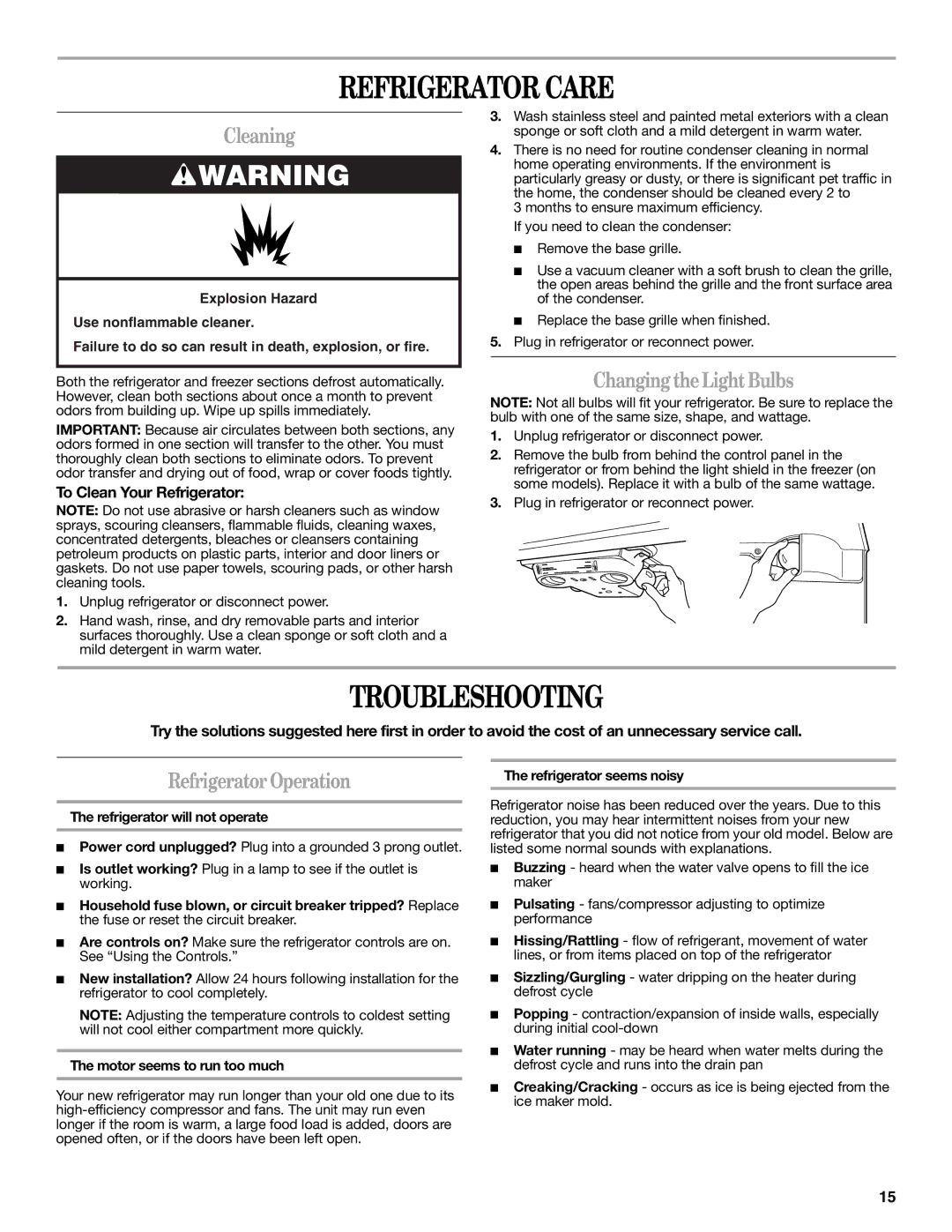
REFRIGERATOR CARE
Cleaning
![]() WARNING
WARNING
Explosion Hazard
Use nonflammable cleaner.
Failure to do so can result in death, explosion, or fire.
Both the refrigerator and freezer sections defrost automatically. However, clean both sections about once a month to prevent odors from building up. Wipe up spills immediately.
IMPORTANT: Because air circulates between both sections, any odors formed in one section will transfer to the other. You must thoroughly clean both sections to eliminate odors. To prevent odor transfer and drying out of food, wrap or cover foods tightly.
To Clean Your Refrigerator:
NOTE: Do not use abrasive or harsh cleaners such as window sprays, scouring cleansers, flammable fluids, cleaning waxes, concentrated detergents, bleaches or cleansers containing petroleum products on plastic parts, interior and door liners or gaskets. Do not use paper towels, scouring pads, or other harsh cleaning tools.
1.Unplug refrigerator or disconnect power.
2.Hand wash, rinse, and dry removable parts and interior surfaces thoroughly. Use a clean sponge or soft cloth and a mild detergent in warm water.
3.Wash stainless steel and painted metal exteriors with a clean sponge or soft cloth and a mild detergent in warm water.
4.There is no need for routine condenser cleaning in normal home operating environments. If the environment is particularly greasy or dusty, or there is significant pet traffic in the home, the condenser should be cleaned every 2 to
3 months to ensure maximum efficiency. If you need to clean the condenser:
■Remove the base grille.
■Use a vacuum cleaner with a soft brush to clean the grille, the open areas behind the grille and the front surface area of the condenser.
■Replace the base grille when finished.
5.Plug in refrigerator or reconnect power.
Changing theLightBulbs
NOTE: Not all bulbs will fit your refrigerator. Be sure to replace the bulb with one of the same size, shape, and wattage.
1.Unplug refrigerator or disconnect power.
2.Remove the bulb from behind the control panel in the refrigerator or from behind the light shield in the freezer (on some models). Replace it with a bulb of the same wattage.
3.Plug in refrigerator or reconnect power.
TROUBLESHOOTING
Try the solutions suggested here first in order to avoid the cost of an unnecessary service call.
RefrigeratorOperation
The refrigerator will not operate
■Power cord unplugged? Plug into a grounded 3 prong outlet.
■Is outlet working? Plug in a lamp to see if the outlet is working.
■Household fuse blown, or circuit breaker tripped? Replace the fuse or reset the circuit breaker.
■Are controls on? Make sure the refrigerator controls are on. See “Using the Controls.”
■New installation? Allow 24 hours following installation for the refrigerator to cool completely.
NOTE: Adjusting the temperature controls to coldest setting will not cool either compartment more quickly.
The motor seems to run too much
Your new refrigerator may run longer than your old one due to its
The refrigerator seems noisy
Refrigerator noise has been reduced over the years. Due to this reduction, you may hear intermittent noises from your new refrigerator that you did not notice from your old model. Below are listed some normal sounds with explanations.
■Buzzing - heard when the water valve opens to fill the ice maker
■Pulsating - fans/compressor adjusting to optimize performance
■Hissing/Rattling - flow of refrigerant, movement of water lines, or from items placed on top of the refrigerator
■Sizzling/Gurgling - water dripping on the heater during defrost cycle
■Popping - contraction/expansion of inside walls, especially during initial
■Water running - may be heard when water melts during the defrost cycle and runs into the drain pan
■Creaking/Cracking - occurs as ice is being ejected from the ice maker mold.
15
